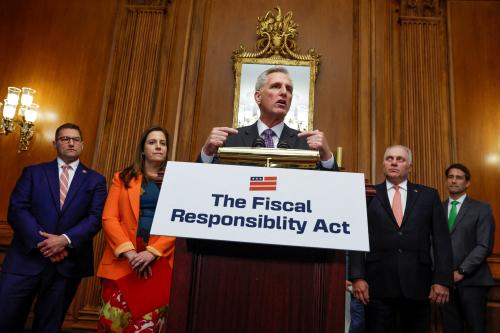Building a computer game on the federal budget, as we did with The Fiscal Ship (www.fiscalship.org), is a challenge. We wanted the game to be engaging and easy to grasp for people who aren’t familiar with budget minutiae. We wanted the numbers, while approximate, to be accurate enough to be meaningful. And we wanted to avoid a game that fueled unwarranted alarmism about today’s budget deficits or excessive complacency about the future.
Defining Sustainability
A few people have poked at our definition of fiscal sustainability in The Fiscal Ship. To “win,” a player needs to make spending and tax choices that reduce the debt/GDP ratio in 2041 to 75% from the 126% that’s projected for that year if tax and spending policy remains unchanged.
“What’s magic about 75%?” someone asked us on Twitter. Short answer: Nothing. To make the game playable, we had to pick a target somewhat arbitrarily and we chose 75% because that’s where the debt/GDP ratio is today. It struck us as a reasonable target.
Some folks think that 75% is too high. After all, measured against the size of the economy, the debt was half that level before the Great Recession. They’d be more comfortable with raising taxes or cutting spending more so that the debt will be lower in 2041. Some argue that 60% is a better target for developed economies, a level written into the Maastricht Treaty in Europe. A lower debt, they argue, would give the U.S. more flexibility to cut taxes or raise spending if the U.S. is hit by a bad recession. This is known as “creating fiscal space” or “reloading the fiscal cannon.” A lower debt, they say, would reduce the risk of a financial crisis and sharply higher interest rates if, someday, global investors decided they didn’t want to lend so much so cheaply to the US Treasury.
Other folks think 75% is unnecessarily austere. They think the U.S. economy can do just fine with a higher debt, particularly if the borrowing goes to finance public investment in infrastructure, research, and education that’ll pay off in higher living standards for future generations. And they worry that too much fiscal austerity too soon will be self-defeating because it will hurt the pace of economic growth, and that’d make it harder to service the debt.
Bottom line: There is no consensus on a precise debt /GDP ratio that is safe or prudent, a point International Monetary Fund economists have made. But there is a fairly broad consensus that, without a course correction, the federal government’s debt load will get heavier and heavier (in part because an aging population will put more demands on federal spending) and that the budget is on an unsustainable trajectory. What does “unsustainable” mean? Well, here’s how the U.K. Office of Budget Responsibility (the analog to the Congressional Budget Office) puts it: “Broadly speaking, the fiscal position is unsustainable if the public sector is on course to absorb an ever-growing share of national income simply to pay the interest on its accumulated debt.” That’s the course the U.S. is on.
Predicting the Future
Now, there are folks who question not the goal, but anyone’s ability make accurate economic and budget projections out 25 years. They wonder why we should worry today about a problem that might not materialize. We agree there’s a lot of uncertainty about 25-year projections; indeed, we once held a conference on that subject. But ignoring 25-year projections and hoping we’re lucky strikes us as imprudent. We look at this much the way the U.K. Office of Budget Responsibility describes its Fiscal Sustainability Report: “The projections are not intended to be a prediction of the future as it will actually be, rather they are designed to capture some of the fundamental trends that will influence economic and budgetary outcomes should policies remain similar to current settings. They help to inform us about where there are opportunities to be seized, and where there are challenges to be overcome.”
Playing the Game
In The Fiscal Ship, we try to allow players to follow their consciences: you can choose a “fiscal hawk” governing goal that takes the debt/GDP ratio to 39% of GDP, the 50-year average. Or you can disregard our target of 75% altogether and just focus on achieving the governing goals of your choice, though you won’t “win” that way. We hope you’ll try it and see if you can meet your governing goals and put the federal budget on a course to bring the debt under control in 2041—regardless of where you’d set the target.



Commentary
How we picked the debt goal for The Fiscal Ship
April 27, 2016